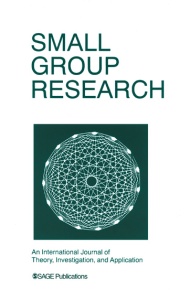Charles Pavitt on Social Influence During Group Decision Making
 [Editor’s Note: A special thanks to Charles Pavitt of University of Delaware, who took the time to give us some background on his article “An Interactive Input–Process–Output Model of Social Influence in Decision-Making Groups,” recently published in Small Group Research.]
[Editor’s Note: A special thanks to Charles Pavitt of University of Delaware, who took the time to give us some background on his article “An Interactive Input–Process–Output Model of Social Influence in Decision-Making Groups,” recently published in Small Group Research.]
I have been interested in social influence during group decision making since the mid 1990s. At that time, I was teaching small group communication a lot and using one of the classic Kogan/Wallach choice dilemmas as an exercise when teaching about the group polarization effect (tendency for groups to polarize  in the direction the members originally lean toward). After watching at least 100 student groups doing the exercise, I realized that there were some communicative phenomena that were not adequately addressed in the then-current social psychological theory regarding group polarization. First, there was a natural stage process (first exchange preferred option, then exchange relevant information but only if there is disagreement on preferred options) that probably generalizes to any group decision making. Second, and I verified this later in my research, if groups are in general agreement on one option, they NEVER have anything good to say about any other option (which is why groups usually don’t find the better option in hidden profile research, in which each member’s information suggests one option but the information everyone has as a whole favors a better option).
in the direction the members originally lean toward). After watching at least 100 student groups doing the exercise, I realized that there were some communicative phenomena that were not adequately addressed in the then-current social psychological theory regarding group polarization. First, there was a natural stage process (first exchange preferred option, then exchange relevant information but only if there is disagreement on preferred options) that probably generalizes to any group decision making. Second, and I verified this later in my research, if groups are in general agreement on one option, they NEVER have anything good to say about any other option (which is why groups usually don’t find the better option in hidden profile research, in which each member’s information suggests one option but the information everyone has as a whole favors a better option).
Later, I came to realize that the traditional distinction between two types of group social influence (normative and informational) was a product of research without true group communication, and there are in actuality three types – that based on learning new relevant information, that based on learning the option preferences of trusted group members, and that based on wanting the group to like you or wanting the boss to accept you (which encompasses verbal compliance but no true preference change). Anyway, the motivation for this paper was based on these two insights – that there are three routes to social influence, and they unfold and intertwine over time in ways previous theory did not sufficiently describe.
[Interest in chatting with Dr. Pavitt about his work? You can email him at chazzq (at) udel (dot) edu. You can also click here to read “An Interactive Input–Process–Output Model of Social Influence in Decision-Making Groups” for free from Small Group Research! Want all the latest news and research from Small Group Research sent directly to your inbox? Click here to sign up for e-alerts!]
 Charles Pavitt is a professor in the Department of Communication at the University of Delaware, United States. He enjoys doing scholarly work relevant to small group and interpersonal communication, communication theory, and (in his spare time) baseball.
Charles Pavitt is a professor in the Department of Communication at the University of Delaware, United States. He enjoys doing scholarly work relevant to small group and interpersonal communication, communication theory, and (in his spare time) baseball.






























































































